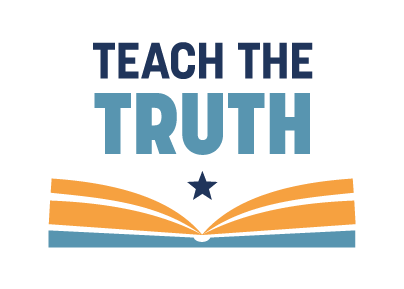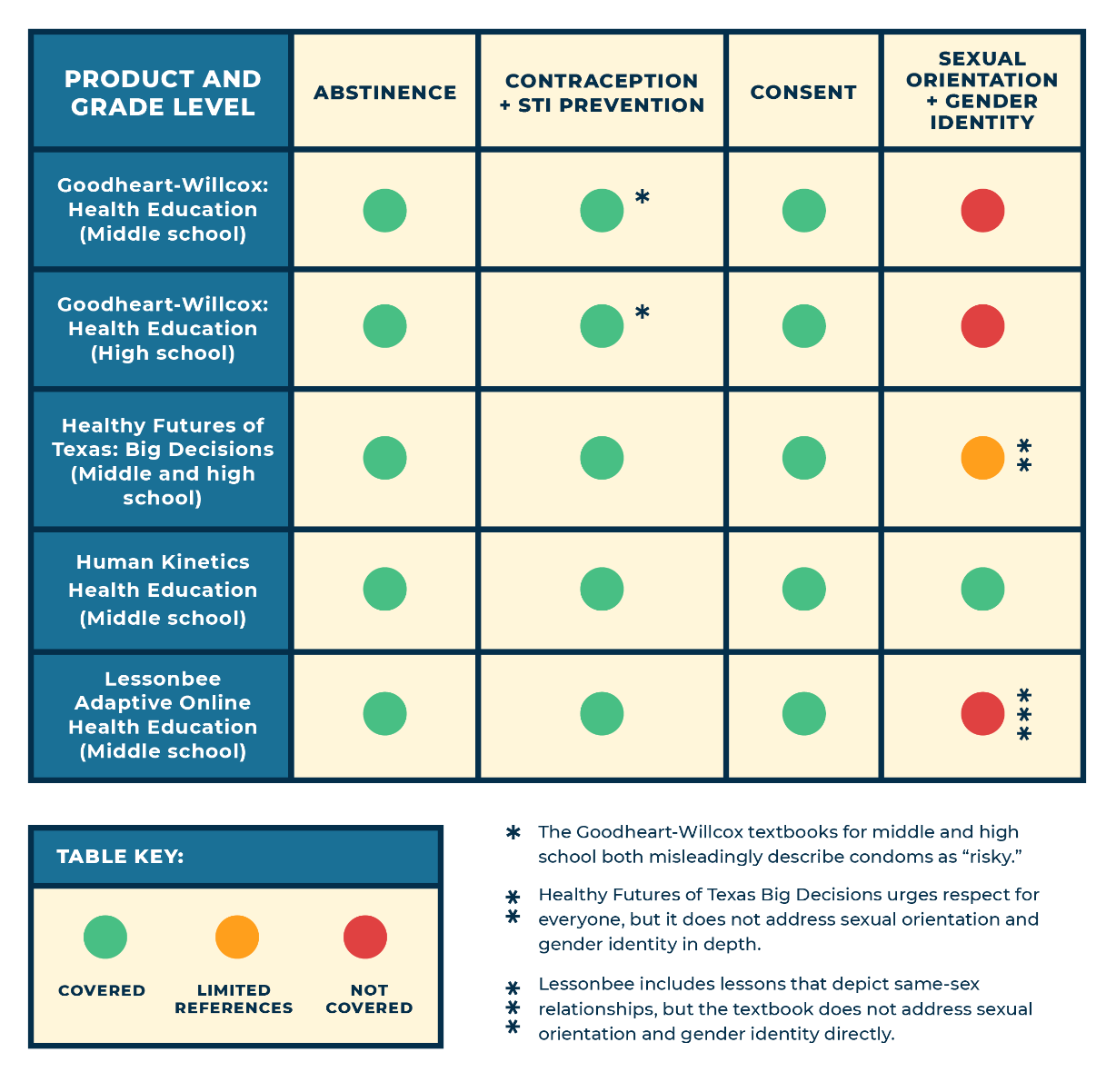
Sex Education in Proposed Texas Health Textbooks
Comprehensive and Inclusive?
The State Board of Education (SBOE) is set to vote in November 2021 on proposed new digital instructional materials — “textbooks” — for health classes in Texas public schools. This is the first health textbook adoption in Texas since 2004. Sex education opponents that year successfully opposed the inclusion of information on contraception and the prevention of sexually transmitted infections (STIs). But the SBOE’s new Texas Essential Knowledge and Skills (TEKS) curriculum standards for health, adopted in November 2020, cover contraception and STI prevention as well as abstinence.
Publishers this spring submitted their new health textbooks, written based on the new TEKS adopted in November 2020, for adoption in Texas. Their products provide content in various online formats, including traditional textbook format, interactive lessons and video. The textbooks are all available for public review on the Texas Education Agency website.
The Texas Freedom Network Education Fund recruited seven graduate students from the University of Texas School of Public Health to review the proposed textbooks. These reviewers included a pediatrician specializing in adolescent health, an assistant professor of nursing, and others who have provided sex education or services related to reproductive health care.
All five digital textbooks submitted by publishers this year for middle school and high school health classes in Texas emphasize abstinence from sexual activity as the only certain way to avoid unplanned pregnancy and sexually transmitted infections. But do the textbooks cover other topics — like methods of contraception and STI prevention, consent in sexual relationships, and sexual orientation and gender identity — that are important as part of comprehensive and inclusive sex education?
In the following table, the reviewers identify what each textbook does or does not cover.
Abstinence
All of the textbooks repeatedly emphasize abstinence from sexual activity as the only method that, if maintained, is certain to prevent pregnancy and STIs. Some of the textbooks employ shaming and stigmatizing language to reinforce this abstinence message, such as the Goodheart-Willcox middle school product that includes a lesson about a young person whose image of his older brother was “shattered” when his sibling revealed an STI diagnosis. Other products, particularly the Healthy Futures program, caution against such an educational strategy. Indeed, stigmatization can discourage individuals from seeking help if they think they might be pregnant or have been exposed to an STI.
Contraception/STI Prevention
All of the textbooks publishers submitted for Grades 7-8 and high school provide coverage of condoms and other methods of contraception and STI prevention. Some textbooks also include information on PrEP, or pre-exposure prophylaxis, which is a daily medication to prevent HIV infection.
While the information about contraception and STI prevention is generally comprehensive and factually accurate, at times discussions deliver problematic messages when discussing effectiveness. For example, the Goodheart-Willcox middle and high school textbooks both warn that condoms are “risky” because they sometimes fail. While students must understand that condoms are not 100% effective, describing a method that is actually very effective at protecting against pregnancy, HIV and many STIs as “risky” could discourage young people who become sexually active from using any protection at all. Sex education opponents often promote this dangerous “risky” message about condoms.
Consent
Despite a reluctance by a majority of Texas SBOE members to address this topic specifically in the new health TEKS, the proposed textbooks generally cover the importance of consent in sexual relationships. In most cases the textbooks frame the discussion in terms of legal consent, but they also cover important concepts related to informed and affirmative consent.
The Human Kinetics textbook for Grades 6-8, for example, makes the concept clear: “You must give sexual consent every time you are sexually active; just because you have been sexually active before with that person doesn’t mean you will be sexually active in the future with that person.” Similarly, the Goodheart-Willcox middle school textbook defines legal consent as “direct, verbal, freely given agreement that occurs when someone older than the legal age of consent clearly says yes.” All of the textbooks emphasize the importance of seeking consent and respecting boundaries set by others.
Sexual Orientation and Gender Identity
Coverage of sexual orientation and gender identity and expression is much more limited — or missing altogether — in the textbooks. Human Kinetics provides the most substantive and affirming discussion, including defining cisgender, transgender, gender nonbinary and gender nonconforming for students.
The Healthy Futures textbook for Grades 7-12 provides brief mentions, including this guidance for instructors: “It is important to maintain a safe, respectful, and inclusive learning environment for all students, including lesbian, gay, bisexual, and transgender students, as well as students who are questioning or unsure of their orientation or gender. Discussions about anatomy and sex can be difficult in this regard. Facilitators should choose words thoughtfully so that no student feels excluded from the discussion. For example, it is important to recognize that not all students who identify as male have a penis and testicles. Likewise, not all who identify as female have a vagina and a uterus.”
Lessonbee doesn’t address the topics directly but depicts a same-sex relationship in at least one lesson. Goodheart-Willcox does not address the topics in its middle school and high school textbooks.
Conclusion
The middle school and high school health textbooks submitted for adoption in Texas this year represent important progress over the abstinence-only health textbooks adopted by the State Board of Education in 2004. In addition to emphasizing abstinence, the new textbooks include comprehensive information on contraception and STI prevention methods as well as the importance of consent in sexual relationships. But most of the textbooks fall far short of providing information that is particularly relevant to the lives of LGBTQ students in the classroom. To address this, the SBOE must revise the health curriculum standards to ensure instruction in Texas health classes includes information on sexual orientation, gender identity and gender expression.


